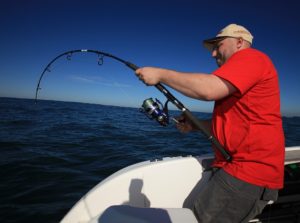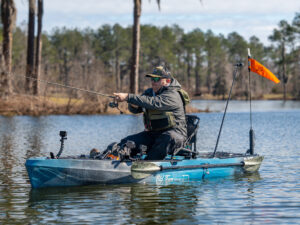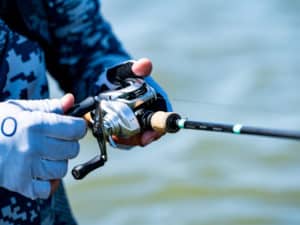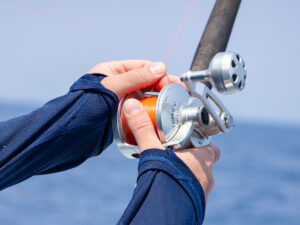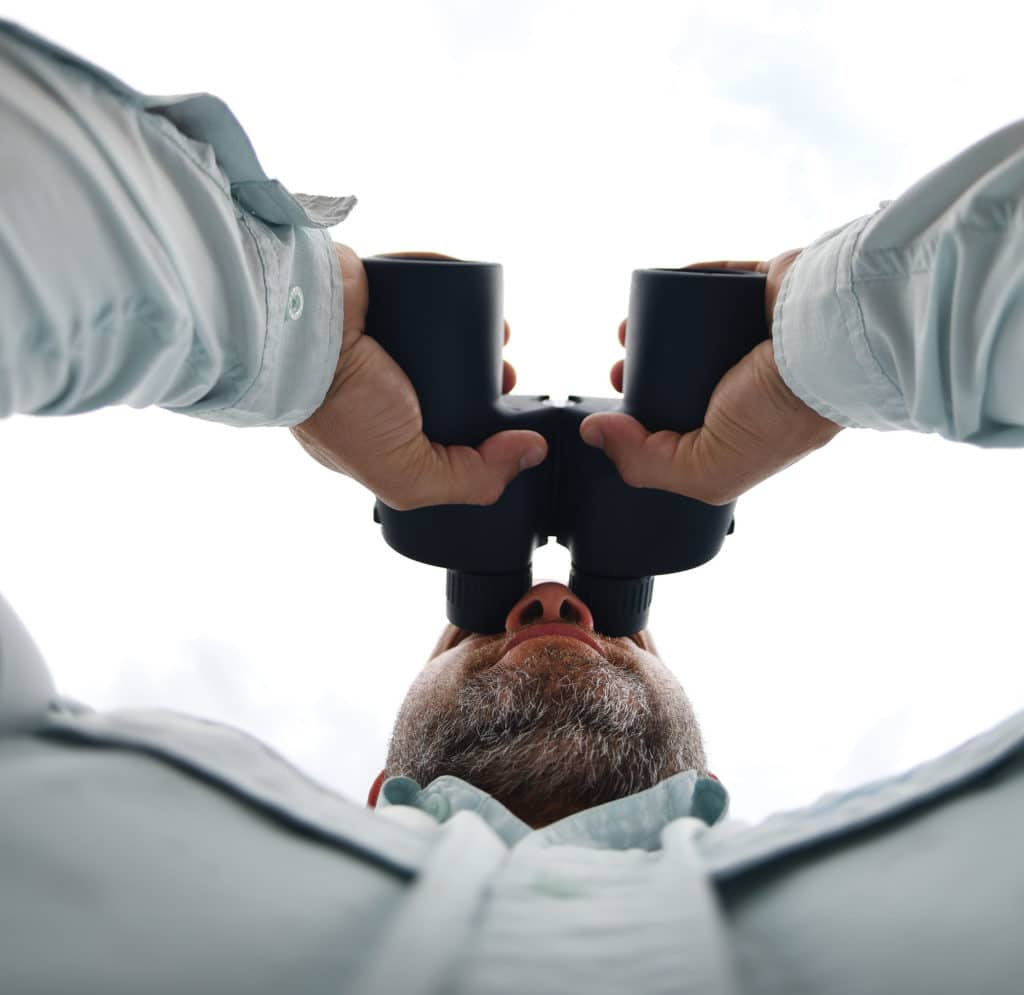
Successful captains always carry a pair or two of high-end glasses on their boat. Their binoculars help them spot birds that are on fish, floating debris that might harbor dolphin or wahoo, and tournament boats that are fighting sailfish or marlin and don’t want the rest of the fleet to know that they’re hooked up.
The best binoculars feature image stabilization, which allows captains to find what they’re looking for even when they’re perched in the tuna tower in rough seas. Good optics are expensive, but compared with the cost of a boat, tackle or fuel for a day’s fishing, they’re a bargain.
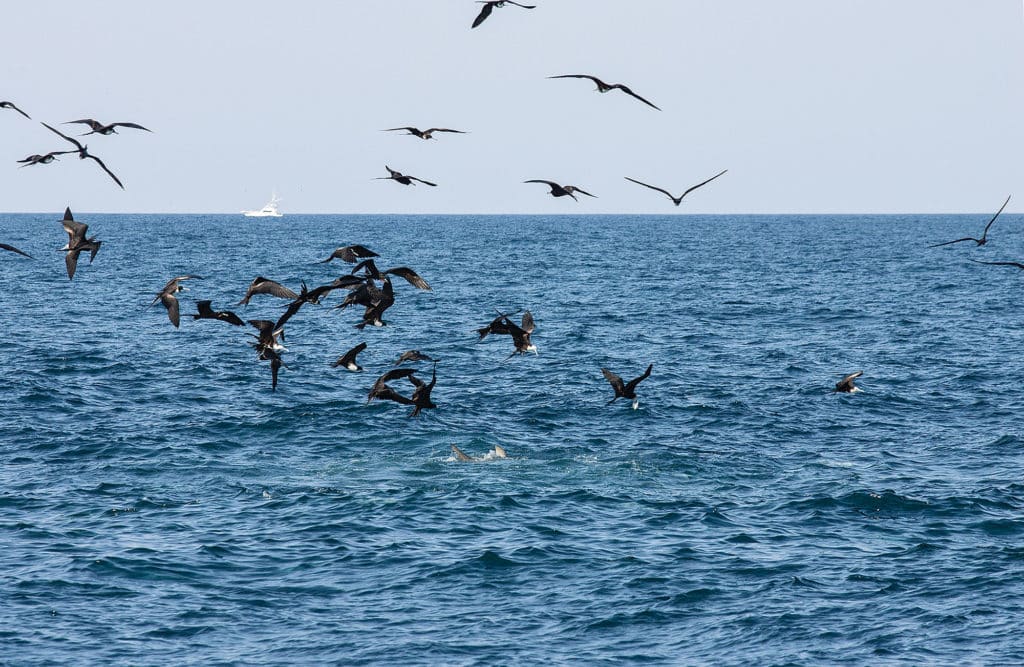
Bino Benefits
Capt. Matt Carter grew up fishing out of North Carolina’s Oregon Inlet and has skippered boats all over the Atlantic Ocean. He doesn’t leave the dock without a pair of gyro-stabilized binoculars.
“They definitely serve a purpose. It makes life a lot easier, especially looking for birds,” says Carter, who has Fraser and Fujinon glasses. “Fishing the south side of the Dominican Republic in winter, it’s all FAD fishing. You’re in a rough ocean with whitecaps everywhere, and you’re looking for a 2-by-2 Styrofoam block, two on top of each other, in an ocean of white. That’s where those gyro-stabilized binoculars really help you out. They’re worth their weight in gold.”
Captains in California who troll flying fish from a kite for bluefin tuna stare through gyro-stabilized binoculars for hours at a time just to see the ribbon on their kite line, which is typically more than 200 yards from the boat. That way they can make sure their bait is where it needs to be.
Read Next: Securely Stow Marine Binoculars on Your Fishing Boat
When Capt. Mark Lamb fishes marlin tournaments on Sweet Beaver out of Orange Beach, Alabama, a pair of Swarovski binoculars is always in use.
“In the Gulf of Mexico, you’re looking for birds, for any form of life, really, because you’re 100 miles offshore,” Lamb says. “One guy [on my boat] has always got the binocs; he’s up in the tower and always looking, all the time.
“You’ll be trolling a weed line, and he’ll be looking forward to see if he sees anything on that weed line: birds, flying fish being chased, a tree limb, anything random. And when he sees something, he tells you, ‘Get ready boys!’ We’ve caught some big yellowfin and dolphin doing this.”
Carter says that while radar is good for locating birds, high-end binos allow him to see what types of birds are working, which tells him what species of fish they’re on.
“You can tell a lot from radar, but there’s no substitute for your two eyes. I can see if the birds are shearwaters or terns and on skipjack or yellowfin tuna,” says Carter, who also uses his binoculars to locate friends who are on fish but don’t want anyone else to know, so they talk in code on the VHF radio.
“Lots of times, there’ll be a fleet of boats fishing white marlin fishing out of Ocean City, Maryland, and Virginia Beach, Virginia, and no one’s talking on the radio. You have to be able to pick up your glasses and find your buddy. The fleet might be 2 or 3 miles wide. Your buddy might say, ‘I’m on the north side of [a particular boat],’ and you can find that boat with your binoculars and head over.”
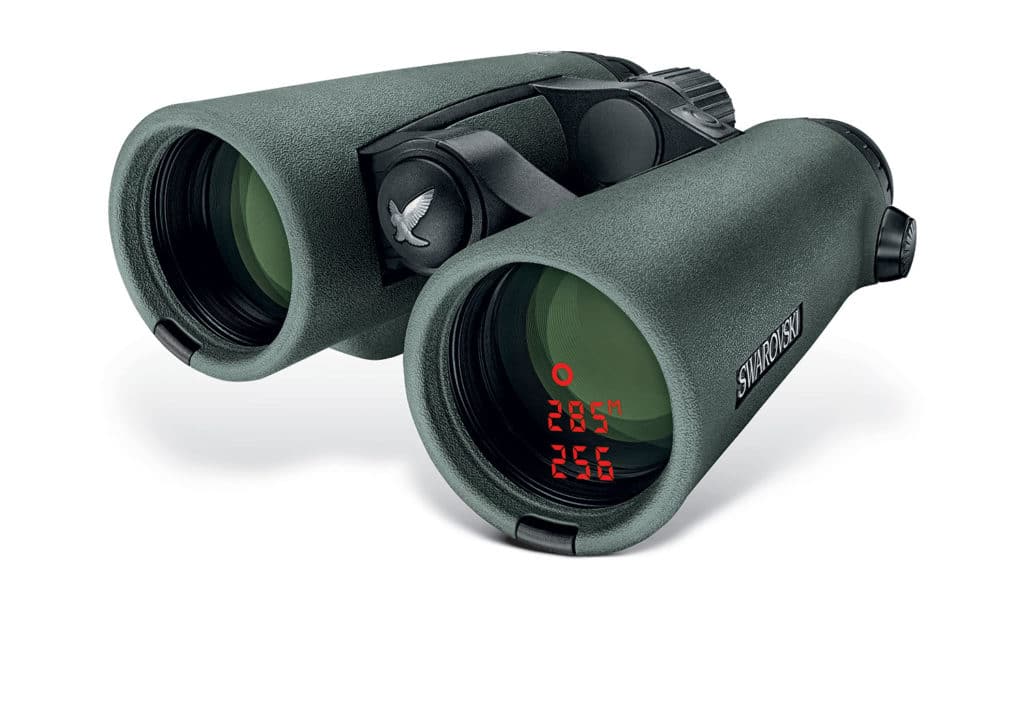
By The Numbers
Two considerations when purchasing binoculars merit serious attention: magnification and effective diameter. A pair of 10×42 binos magnify at 10x with a diameter of the lenses at the front of the glasses of 42 millimeters. An 18×50 pair would be more powerful and able to see objects at a greater distance and have a larger diameter.
In general, the larger the diameter, the brighter the view. A larger exit-pupil diameter also makes for a brighter view. Glasses with a large diameter and a lower magnification have a greater pupil diameter, which makes the image appear brighter. So a 10×42 would have a pupil diameter of 4.2 millimeters, and the 18×50’s pupil diameter would measure 2.8 millimeters.
The size of the area that can be seen with binoculars, known as the field of view, also is important to consider. Glasses with higher magnification have a narrower field of view, good for viewing distant objects. Models with a large field of view make it easier to follow moving objects.
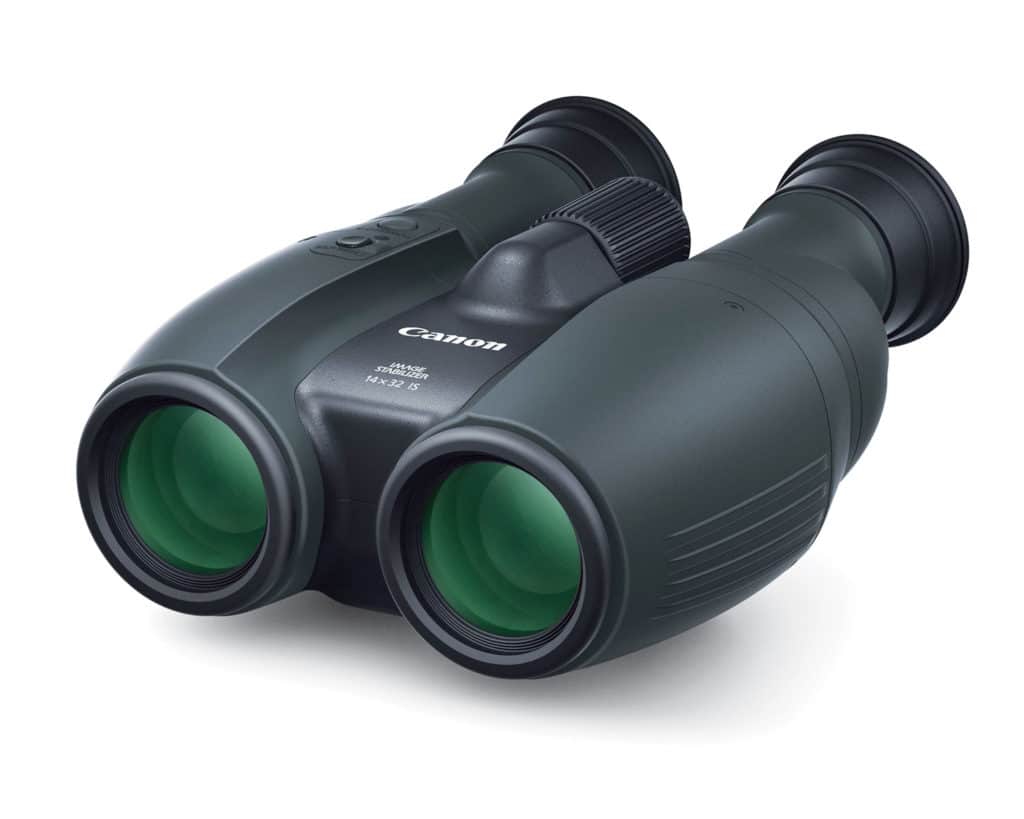
Worth The Price
Features such as image stabilization, high-clarity lenses, and excellent light transmission don’t come cheap. Prices for high-end binoculars can approach $5,000.
Fraser S250 Stabilized Binoculars (fraseroptics.com) have a suggested retail price of $3,695. The advanced gyro-stabilization system reduces image motion by up to 98 percent. The 14-power glasses offer a wide field of view, and are 100 percent sealed, buoyant, submersible, waterproof and shockproof. They feature a nonslip silicone covering for comfort and a secure grip, as well as a lifetime warranty. Fraser also sells the factory refurbished 14×40 M25E for $2,995.
Carter jokes that the price tag for his Frasers can make a fisherman cringe, “but you get what you pay for. You spend all this money on your boat, nice motors, electronics, an LP electric reel. Why not spend a few extra thousand on glasses?”
Lamb adds, “If you’re going to spend $50,000 to fish a blue marlin tournament in a million-dollar sport-fisherman with thousands of dollars in rods and reels, your $3,500 binoculars are pretty cheap.”
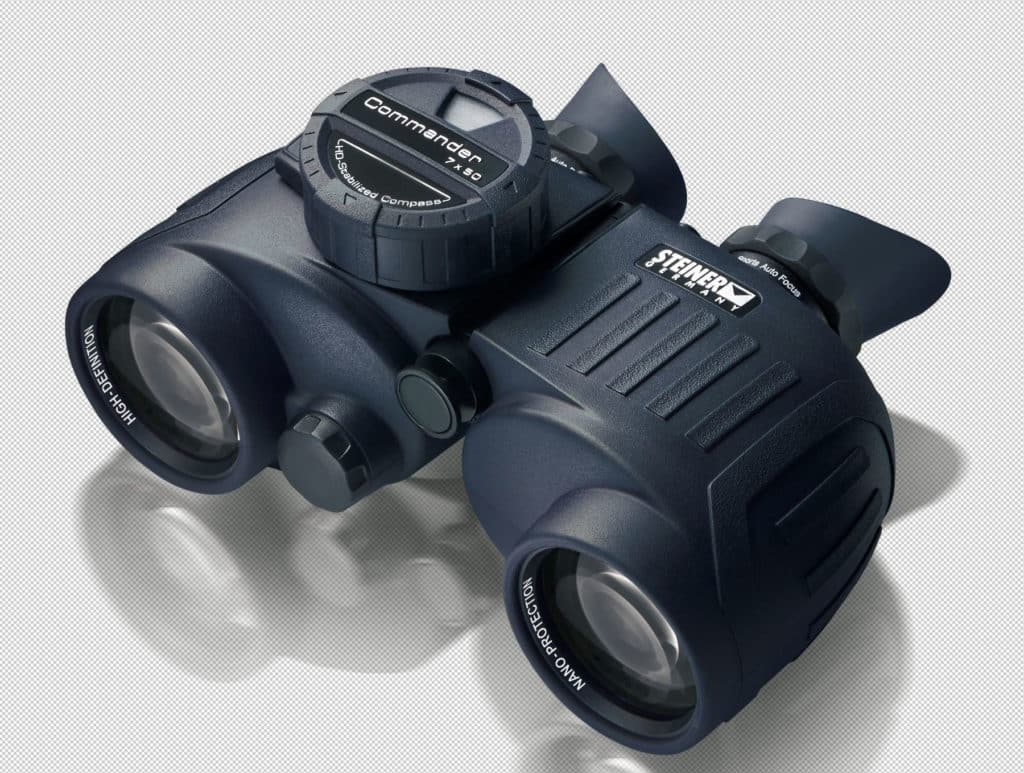
Swarovski (swarovskioptik.com) no longer offers gyro-stabilized models, but the company recommends several of its waterproof 8x magnification glasses for marine use. (Binoculars stronger than 8x could be too unsteady in bumpy seas and have been known to make users seasick.) Swarovski’s EL 8×32 glasses are lightweight, have a 423-foot field of view at 1,000 yards, and retail for $2,443. The EL Range 8x42s can measure the distance to objects up to 1,500 yards away, have a 411-foot field of view, and are priced at $3,632. The SLC 8×56 binos, which are optimized for night use and have a 400-foot field of view, sell for $2,399.
Canon’s (usa.canon.com) binoculars are all image-stabilized. The newest models — 14×32, 12×32 and 10×32 — range in price from $1,449 to $1,349 and feature Lens Shift Image Stabilization Technology. That moves the lens assembly so the image remains steady and incorporates a vibration gyro mechanism that helps cancel out the effects of user shake or movement. They’re the first Canon binos with Powered Image Stabilization, which further corrects for shake and movement. Canon offers a waterproof model in 10×42 for $1,999. Canon’s most powerful binos are the 18×50 and 15×50, which are water- and weather-resistant, and retail for $1,999 and $1,699.
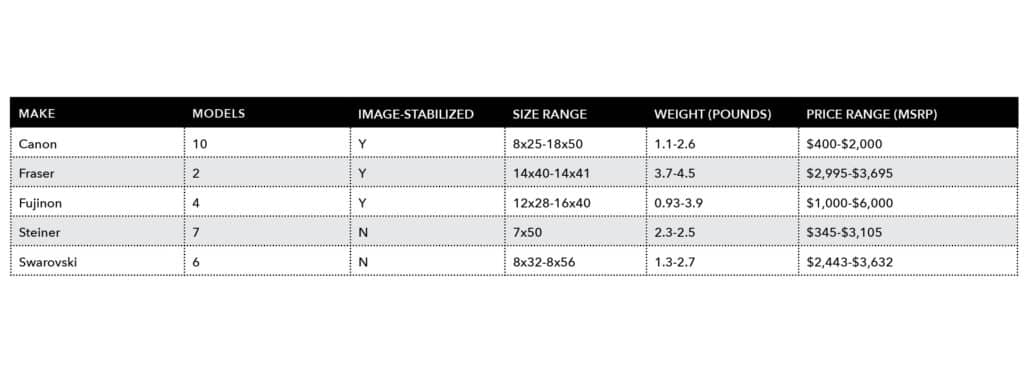
Fujinon (fujifilmusa.com) makes two types of image-stabilized binos: the Techno-Stabi 12×28 and 14×40 and the Stabiscope 12×40 and 16×40. Steiner (steiner-optics.com) makes several models of marine binoculars. The 7×50 Commander Global features Steiner’s Diamond Marine lens coating and an integrated digital compass that works anywhere in the world, so when you spot an object worth investigating, your boat can head straight for it. The MSRP is $3,105. The Commander 7x50c ($1,495) comes with a zone‑specific compass.

